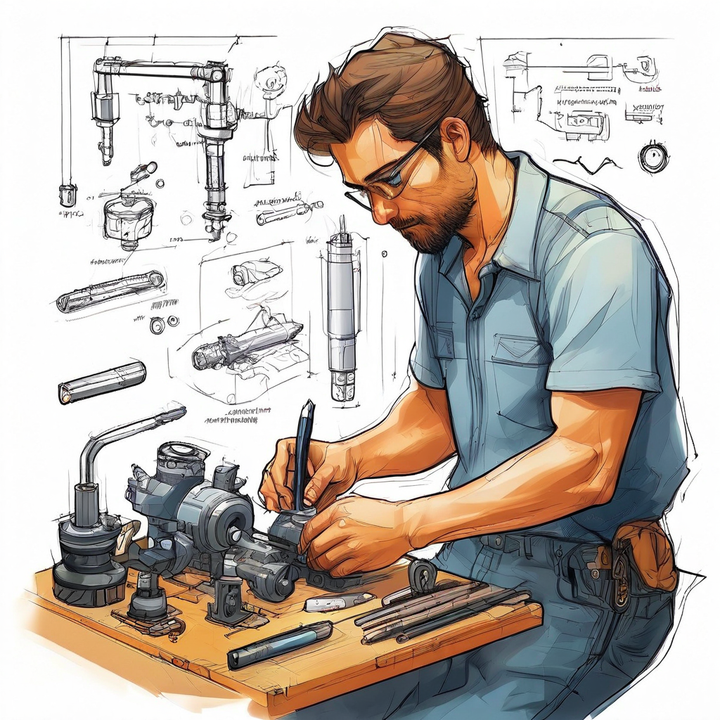


The diagnostic trouble code P03C9 indicates an issue with the pressure sensor circuit for cylinder 6 of the engine. Specifically, it means that the pressure sensor circuit for cylinder 6 is detecting a low voltage signal, which could be caused by various problems.
Before we dive into the nitty-gritty details, let's first grasp the essence of this code. The P03C9 code is a diagnostic trouble code (DTC) that indicates an issue with the cylinder 6 pressure sensor circuit. This sensor plays a crucial role in monitoring the combustion pressure within the sixth cylinder of your engine, providing valuable data to the powertrain control module (PCM/ECM) for optimal engine performance and efficiency.
| Sensor | Function |
|---|---|
| Cylinder 6 Pressure Sensor | Monitors combustion pressure in cylinder 6 |
| Provides data to PCM/ECM for engine optimization |
Now, let's explore the usual suspects that might be causing this code to rear its mischievous head:
Wiring issues
Open circuit
Short to ground
Faulty cylinder 6 pressure sensor
Damaged connectors or wiring harness
Issue with the powertrain control module (PCM/ECM)
One of the most common culprits is a wiring issue within the cylinder 6 pressure sensor circuit. These pesky wiring gremlins can wreak havoc on the sensor's ability to communicate with the PCM/ECM, leading to erratic readings or no readings at all.
Open circuit: An open circuit means there is a break in the electrical path, preventing the flow of current.
Short to ground: A short to ground occurs when the circuit is inadvertently connected to the vehicle's ground, causing a short circuit.
Another potential offender is the cylinder 6 pressure sensor itself. Like any component, these sensors can fail over time due to various factors:
Wear and tear
Exposure to extreme temperatures
Manufacturing defects
A faulty sensor will send incorrect or erratic data to the PCM/ECM, triggering the dreaded P03C9 code.
Damaged connectors or wiring harnesses related to the cylinder 6 pressure sensor can also be the root cause of this code. These connectors and harnesses act as the communication highway between the sensor and the PCM/ECM, and any damage or corrosion can disrupt the flow of information, leading to the P03C9 code.
Last but not least, we mustn't overlook the possibility of an issue with the PCM/ECM itself. While less common, a malfunctioning PCM/ECM can misinterpret or fail to receive the data from the cylinder 6 pressure sensor, resulting in the activation of the P03C9 code.
Now that we've identified the potential culprits, it's time to roll up our sleeves and dive into the diagnostic process.
Visual Inspection
Thoroughly inspect the wiring and connectors related to the cylinder 6 pressure sensor.
Look for any signs of damage, corrosion, or loose connections.
Voltage and Ground Check
Use a multimeter to check for proper voltage supply and ground at the cylinder 6 pressure sensor connector.
Ensuring correct power and ground signals is essential for proper sensor operation.
Live Data Stream Analysis
Connect a scan tool and check the live data stream for the cylinder 6 pressure sensor readings.
Identify any abnormalities or erratic behavior in the sensor's performance.
Resistance and Continuity Tests
If the live data stream doesn't provide enough information, perform resistance and continuity tests on the cylinder 6 pressure sensor and its circuit.
These tests will help pinpoint any open circuits, short circuits, or resistance issues.
After completing the diagnostic steps, it's time to tackle the repair process.
| Repair Action | Description |
|---|---|
| Wiring Repair/Replacement | Repair or replace damaged wiring and connectors |
| Sensor Replacement | Replace the faulty cylinder 6 pressure sensor |
| PCM/ECM Reprogramming/Replacement | Reprogram or replace the PCM/ECM (if necessary) |
If wiring issues are identified, repair or replace the damaged wiring and connectors as needed. This may involve:
Splicing in new wires
Replacing connectors
Replacing entire wiring harnesses (depending on the extent of the damage)
If the cylinder 6 pressure sensor itself is found to be faulty, it's time to replace it with a new one. This process may involve:
Removing various components to access the sensor
Proper installation and calibration of the new sensor
In the rare case that the PCM/ECM is suspected to be the culprit, it may need to be reprogrammed or, in some cases, replaced entirely. This is typically a more complex and costly repair, so it's essential to rule out all other potential causes before taking this step.
Once the repairs are complete, it's crucial to take preventative measures to avoid future occurrences of the P03C9 code.
Regular inspections of wiring and connectors for any signs of damage or corrosion
Following the manufacturer's recommended maintenance schedule
Avoiding exposure to excessive moisture or contaminants
The cost of repairs can vary significantly depending on the specific cause of the P03C9 code and the labor rates in your area.
| Repair | Estimated Cost Range |
|---|---|
| Cylinder 6 Pressure Sensor Replacement | $100 - $300 |
| Wiring Harness Replacement | $500 - $1,000 |
| PCM/ECM Replacement | $800 - $1,500+ |
If you're lucky, and the issue is simply a faulty cylinder 6 pressure sensor, you might be looking at a cost range of $100 to $300, including parts and labor.
However, if the issue involves wiring harness or PCM/ECM replacement, the cost can skyrocket. In these cases, you could be looking at a bill ranging from $500 to $1,500 or even more, depending on the complexity of the repair and the specific make and model of your vehicle.
It's essential to weigh the cost of repairs against the overall value and condition of your vehicle. In some cases, it may be more cost-effective to explore alternative options, such as purchasing a used or rebuilt PCM/ECM or even considering a vehicle replacement if the repair costs are too high.
Phew, we've covered a lot of ground today, haven't we? From understanding the P03C9 code to diagnosing and repairing the issue, we've explored the depths of this automotive enigma. Remember, patience and attention to detail are key when tackling this code, as it can be a tricky one to crack.
But fear not, my fellow automotive enthusiasts! With the knowledge and tools at your disposal, you're now equipped to take on the P03C9 code head-on. Embrace the challenge, roll up your sleeves, and let your mechanical prowess shine through.
Until next time, keep those engines purring and those diagnostic codes at bay!
The P03C9 code is a diagnostic trouble code that indicates an issue with the cylinder 6 pressure sensor circuit. This sensor monitors the combustion pressure in cylinder 6 and provides data to the powertrain control module (PCM/ECM) for engine optimization.
The common causes of the P03C9 code include wiring issues (open circuit, short to ground), faulty cylinder 6 pressure sensor, damaged connectors or wiring harness, and issues with the powertrain control module (PCM/ECM).
To diagnose the P03C9 code, you should visually inspect the wiring and connectors, check for proper voltage supply and ground, analyze the live data stream, and perform resistance and continuity tests on the cylinder 6 pressure sensor and its circuit.
The repair steps for the P03C9 code involve repairing or replacing damaged wiring and connectors, replacing the faulty cylinder 6 pressure sensor, and reprogramming or replacing the PCM/ECM (if necessary).
To prevent the P03C9 code from recurring, you should regularly inspect wiring and connectors for damage or corrosion, follow the manufacturer's recommended maintenance schedule, and avoid exposing the engine and electrical components to excessive moisture or contaminants.
The estimated cost range for repairing the P03C9 code can vary significantly, from $100 to $300 for replacing the cylinder 6 pressure sensor, to $500 to $1,500 or more for wiring harness or PCM/ECM replacement.
Yes, a malfunctioning PCM/ECM can misinterpret or fail to receive the data from the cylinder 6 pressure sensor, resulting in the activation of the P03C9 code, although this is less common than other causes.
The cylinder 6 pressure sensor monitors the combustion pressure within the sixth cylinder of the engine and provides valuable data to the PCM/ECM for optimal engine performance and efficiency.
To diagnose wiring issues related to the P03C9 code, you can perform resistance and continuity tests on the cylinder 6 pressure sensor and its circuit to identify any open circuits, short circuits, or resistance issues.
You can use a multimeter to check for proper voltage supply and ground at the cylinder 6 pressure sensor connector, ensuring correct power and ground signals for proper sensor operation.

Miguel started tinkering with car radios as a teenager, fascinated by the intricate dance of wires and circuits. This passion led him to pursue a career as an automotive electrician. For the past 10 years, Miguel has tackled everything from flickering headlights to mysterious electrical gremlins. He thrives on troubleshooting electrical problems and enjoys sharing his knowledge to empower car owners to understand their vehicles better.



